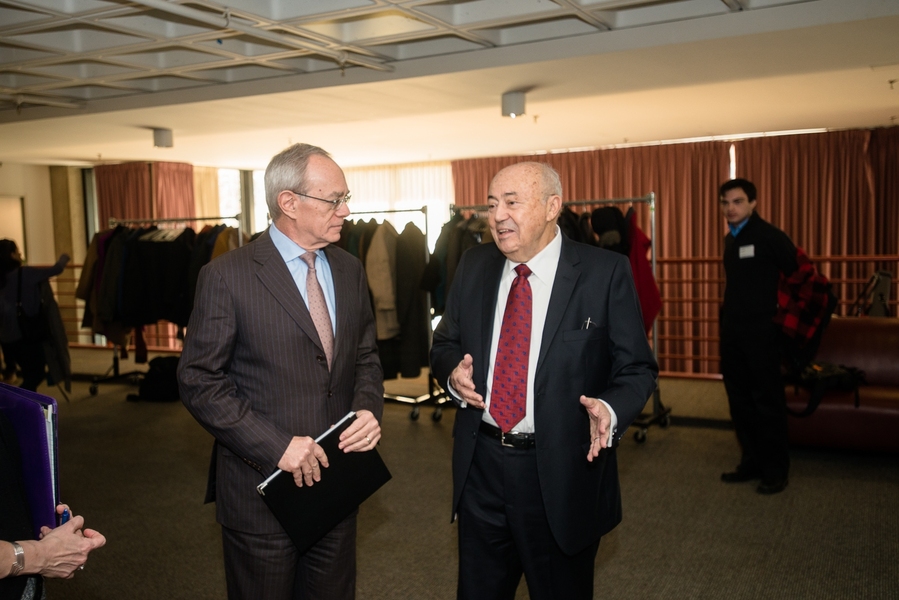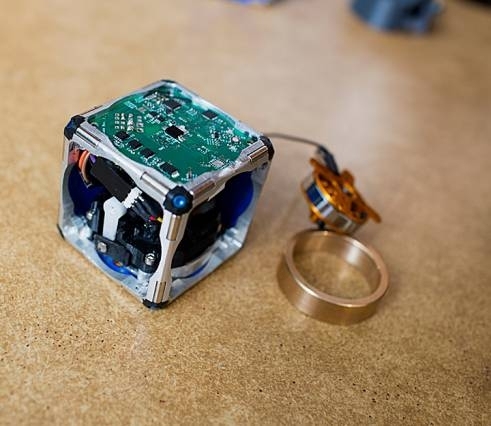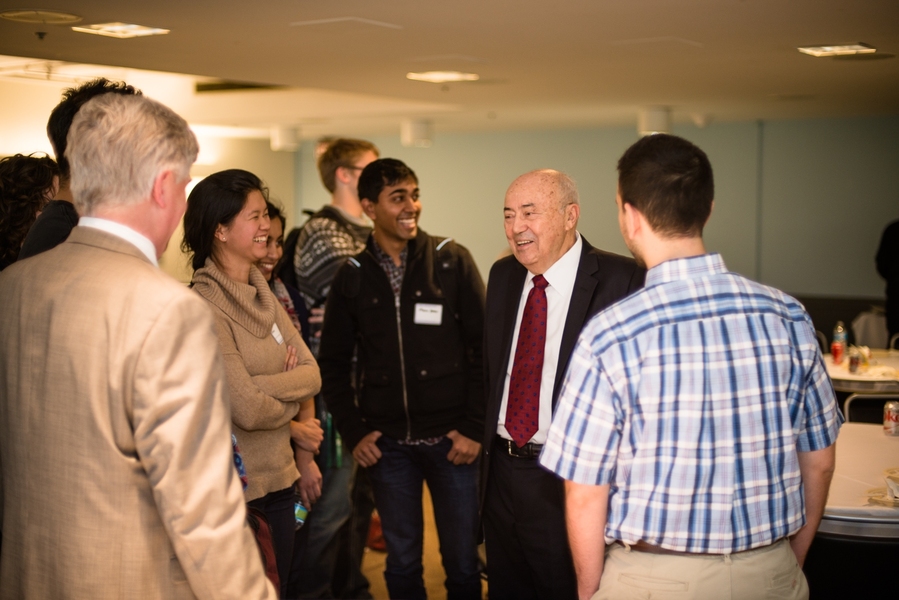If you look around your home or office, chances are you’ll see something that Andrew Viterbi ’56, SM '57 contributed to in a big way. Cell phones, wireless modems, and computers all bear the hallmark of his innovations, especially his breakthrough invention in the 1960s: the Viterbi algorithm, a deceptively simple mathematical formula that enables much of modern wireless communication.
Viterbi’s contributions are all the more noteworthy for the distance he traveled both physically and emotionally to achieve them. His Jewish parents were forced to flee Italy in 1939 due to persecution when he was just 4 years old. Viterbi remembers landing in New York as a child, with almost no money. “I had to really struggle to learn English at first,” he says.
Eventually, the family settled in Boston’s Back Bay, where his father worked as an ophthalmologist, and Viterbi excelled in math and science at Boston Latin School. There, he earned a scholarship to the school across the river: Massachusetts Institute of Technology. He continued to live at home and commute to classes. Without that scholarship help, he says, his family would have struggled to afford MIT.
“My father was not making a lot of money at the time,” he says. “We probably would have found a way to pay for it, but this made it so much easier.” Viterbi never forgot the generosity of MIT in supporting his studies. Earlier this year, he pledged $20 million to MIT, bringing the total he has committed to the Institute to $30 million — all of which will support the research of students and faculty. “Other people may donate the money to build the buildings and fill them with equipment, and there’s nothing wrong with that,” he says. “But you’ve got to fill them with the best, smartest people, in order to produce real innovations.”
That dedication to MIT’s people has earned him both admiration and gratitude at MIT. “Andrew’s record of innovative boldness, combined with his transformative philanthropy, has made him a legend on our campus,” says MIT President L. Rafael Reif, who counts Viterbi as a personal friend. “Andrew embodies the ideals that drive our Institute forward — striving every day to bring knowledge to bear on the world’s greatest challenges.”
Viterbi credits the professors he had at MIT with jump-starting his own career decades ago. “There were other engineering schools at the time, but MIT was years ahead of anyone else,” he says. Graduating in 1957 with a master’s in electrical engineering, he took a position with the Jet Propulsion Laboratory in California, which was then working on missile and satellite guidance systems for the U.S. government. There, he worked on the fundamental problem of how to send radio signals long distances without interference.
Viterbi happened on his own breakthrough almost by accident, in 1966, when, after earning a PhD at the University of Southern California (USC), he took a teaching position at the University of California at Los Angeles. Trying to convey the difficult concept of teasing out radio signals from surrounding “noise,” he developed a deceptively simple mathematical algorithm to process signals using models of probability.
“I was just looking for an easier way to teach my students,” says Viterbi. He quickly realized, however, that he’d developed a powerful tool for improving the transmission of signals — particularly in situations where they were competing with numerous other signals. On the advice of a lawyer, he declined to patent the algorithm — after all, the computers available at the time were not powerful enough to process it. “He said, there’s no way that anyone is going to be able to use this commercially,” Viterbi remembers with a laugh.
But he soon learned otherwise. In the early 1970s, he cofounded a company called Linkabit, which contracted to produce radio transmission for the U.S. Air Force. In 1985, he co-founded Qualcomm, which became a giant in the field of wireless networking. The company’s first projects were in developing a system for trucking companies to communicate with their truckers. At the time, satellites built for digital television transmissions were being underutilized — Qualcomm was able to repurpose them for its own communications network, using the Viterbi algorithm to amplify the weak satellite signals into a useable network.
From that early success, the company developed digital code division multiple access, or CDMA, a technology for cell-phone communications that allowed multiple users to occupy the same wireless bandwidth without interference. The standard was used with 2G networks, and became near ubiquitous with the rollout of 3G in the 2000s, in hundreds of millions of phones worldwide. (4G networks use a different standard.) The Viterbi algorithm is also used in the 802.11 standard specification that enables wireless routers, which Qualcomm also produced.
Since he retired from Qualcomm in 2000 at the age of 65, Viterbi has spent much of his time giving back, with substantial gifts in his name and that of his wife, Erna, to USC, Technion, Boston Latin, and other institutions that helped him in his own career. At MIT, their gifts have established endowed professorships and fellowships for graduate students in the electrical engineering and biological engineering departments — more than 40 students now on campus have received support from the funds — as well as undergraduate scholarships to help MIT maintain its need-blind admissions policy.
“The fellowships are an honor to students and also allows them to pursue research that is more flexible and open-ended,” says Anantha Chandrakasan, head of the Department of Electrical Engineering and Computer Science (EECS) — who notes that Viterbi also advises the department as a member of its Visiting Committee, offering insight into the latest technologies. “He is very thoughtful, and has great insights into the field of communications and some of the directions we should be pursuing,” Chandrakasan says.
Viterbi's gifts provide generous support for faculty members in EECS and biological engineering. “Dr. Viterbi is really an inspiration to many of us who are in communications and networking,” says Dina Katabi SM '99, PhD '03, one of three current Viterbi chairholders. “The Viterbi algorithm is such an amazing piece of technology — so elegant and simple, yet effective, and still in use after so many years. It’s the kind of thing everyone hopes to contribute.”
These professorships also come with seed funds that can be used to conduct research that might not be funded elsewhere. “These discretionary funds are invaluable,” says Daniela Rus, also a current Viterbi chairholder and director of the Computer Science and Artificial Intelligence Laboratory. She used funds from the Viterbi professorship to pursue field studies with robots to help with environmental conservation efforts, as well as for outreach to middle-school students. “I am very passionate about teaching middle schoolers how to program,” says Rus, who is herself an immigrant from Romania. “The U.S. is behind in promoting computer science as part of the regular curriculum, so it’s so important to raise awareness and try and inspire kids.”
Viterbi's vision extends beyond his own fields of study, electrical engineering and communications. His role on the Department of Biological Engineering's Visiting Committee and generous fellowship funds helped to establish the department, after it began accepting majors in 2005. Viterbi sees bioengineering as the next frontier.
“Biotech is where we are going to see the newest and most exciting innovations emerge in the coming years,” says Viterbi. With the help of his generosity, a student may produce the breakthrough that will transform that field in the same way that, 50 years ago, Viterbi transformed the way we communicate today.









